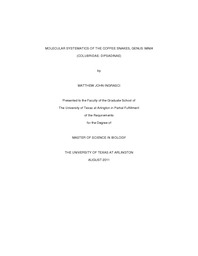
ATTENTION: The works hosted here are being migrated to a new repository that will consolidate resources, improve discoverability, and better show UTA's research impact on the global community. We will update authors as the migration progresses. Please see MavMatrix for more information.
Show simple item record
| dc.contributor.author | Ingrasci, Matthew John | en_US |
| dc.date.accessioned | 2011-10-11T20:49:23Z | |
| dc.date.available | 2011-10-11T20:49:23Z | |
| dc.date.issued | 2011-10-11 | |
| dc.date.submitted | January 2011 | en_US |
| dc.identifier.other | DISS-11169 | en_US |
| dc.identifier.uri | http://hdl.handle.net/10106/6210 | |
| dc.description.abstract | Although previous studies have addressed issues relating to the systematics and taxonomy in the snake genus Ninia, the evolutionary history of the group remains largely unknown. Preliminary morphological studies have been unable to resolve many of the relationships within the genus and have not thoroughly tested the relationship between Ninia and other dipsadine snakes. To address these gaps in our knowledge of Ninia, I used molecular techniques to infer phylogenetic relationships. I obtained tissue samples for all species of Ninia and sequenced two mitochondrial DNA (mtDNA) and one nuclear DNA (nucDNA) locus. In total, this dataset included 2453 base pairs of nucleotide data. Additionally, I obtained tissue samples and sequence data for representatives of other dipsadine genera including Atractus, Chersodromus, Cryophis, Dipsas, Geophis, and Sibon . I reconstructed phylogenetic trees using distance, parsimony, maximum likelihood, and Bayesian inference methods. The mtDNA analyses recovered five well-supported lineages; these include (1) the N. espinali lineage, (2) the N. celata lineage, (3) the N. diademata lineage, (4) the atrata+maculata+psephota lineage, and (5) the N. sebae lineage. Within the atrata+maculata+psephota lineage, N. atrata and N. hudsoni were recovered as sister taxa, but the monophyly of the closely related species N. maculata and N. pavimentata could not be proven. Some of my analyses placed N. psephota within the atrata+hudsoni lineage, and others placed N. psephota within the maculata+pavimentata lineage, leaving relationships among these species unresolved. Deep divergences were observed within N. atrata that correspond to populations geographically isolated by the Cordillera Occidental and the Cordillera Oriental in Ecuador and Colombia. Within the maculata+pavimentata lineage, moderate divergence appears to have occurred between northern and southern populations. Within the N. diademata lineage, the optimal topologies suggest a deep divergence between Atlantic and Pacific populations. The molecular data examined herein offered no evidence to suggest that there has been any substantial diversification in N. sebae across its large geographic range. Analysis of the nucDNA sequence data did not clearly resolve relationships among species of Ninia. The mtDNA analyses support the monophyly of Ninia, but inclusion of the nuclear data suggests a sister relationship between Chersodromus and N. espinali. I hypothesize a Central American origin for the genus, since the most basal split within Ninia produced lineages geographically restricted to Central America | en_US |
| dc.description.sponsorship | Smith, Eric N. | en_US |
| dc.language.iso | en | en_US |
| dc.publisher | Biology | en_US |
| dc.title | Molecular Systematics Of The Coffee Snakes, Genus Ninia (Colubridae: Dipsadinae) | en_US |
| dc.type | M.S. | en_US |
| dc.contributor.committeeChair | Smith, Eric N. | en_US |
| dc.degree.department | Biology | en_US |
| dc.degree.discipline | Biology | en_US |
| dc.degree.grantor | University of Texas at Arlington | en_US |
| dc.degree.level | masters | en_US |
| dc.degree.name | M.S. | en_US |
Files in this item
- Name:
- Ingrasci_uta_2502M_11169.pdf
- Size:
- 3.757Mb
- Format:
- PDF
This item appears in the following Collection(s)
Show simple item record


